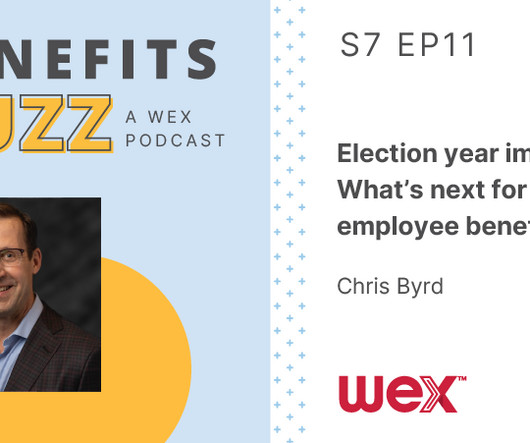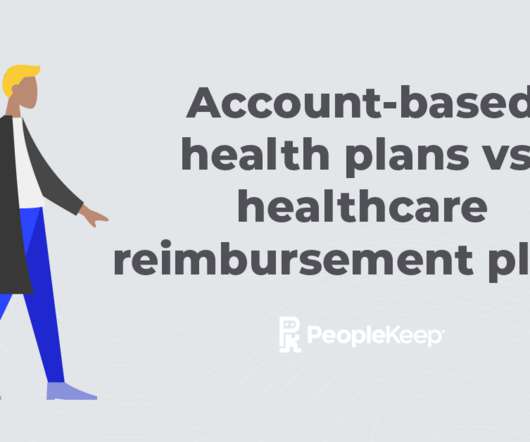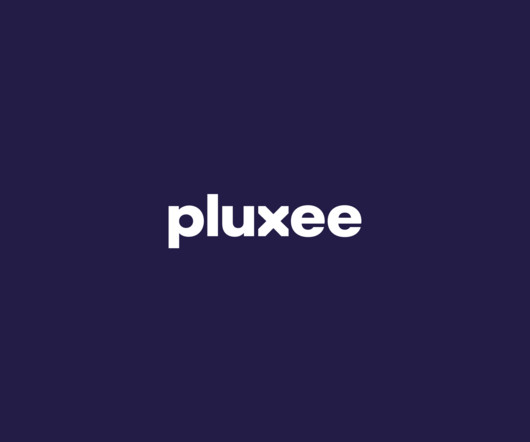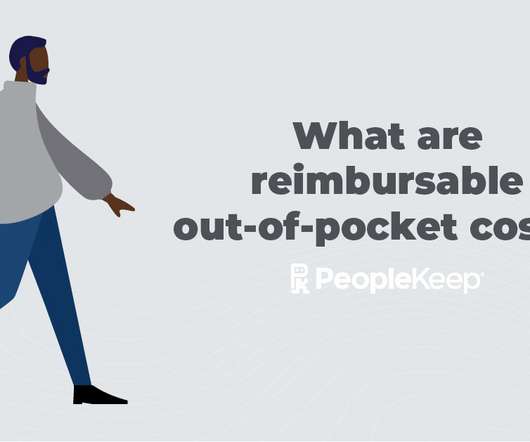$0 copays and deductibles? Curative is helping companies make their healthcare plans accessible
Employee Benefit News
SEPTEMBER 12, 2024
Curative, a healthcare services firm, is working to slash costs and encourage workers to seek treatment earlier.
This site uses cookies to improve your experience. To help us insure we adhere to various privacy regulations, please select your country/region of residence. If you do not select a country, we will assume you are from the United States. Select your Cookie Settings or view our Privacy Policy and Terms of Use.
Cookies and similar technologies are used on this website for proper function of the website, for tracking performance analytics and for marketing purposes. We and some of our third-party providers may use cookie data for various purposes. Please review the cookie settings below and choose your preference.
Used for the proper function of the website
Used for monitoring website traffic and interactions
Cookies and similar technologies are used on this website for proper function of the website, for tracking performance analytics and for marketing purposes. We and some of our third-party providers may use cookie data for various purposes. Please review the cookie settings below and choose your preference.

Employee Benefit News
SEPTEMBER 12, 2024
Curative, a healthcare services firm, is working to slash costs and encourage workers to seek treatment earlier.

Employee Benefit News
OCTOBER 23, 2024
From the lowest number of hospital beds to the highest average deductibles, see which states have the worst healthcare.
This site is protected by reCAPTCHA and the Google Privacy Policy and Terms of Service apply.
Understanding Group Medicare for an Aging Workforce: Key Considerations for HR Leaders
More Than a Benefit: Group Medicare and the Psychology of Retirement

Best Money Moves
SEPTEMBER 25, 2024
Employees Face a Healthcare Crisis. Employees are experiencing a healthcare crisis due to financial concerns. American families are in the midst of a healthcare crisis and employer-sponsored health insurance can’t keep up. Over time, postponing healthcare concerns can further decrease employees’ health and well-being.

Employee Benefit News
NOVEMBER 1, 2023
Jeri Hawthorne, CHRO at Aflac, breaks down the gap between employer-provided benefits and employees' needs.

Employee Benefit News
APRIL 11, 2024
According to a report by LendingTree's ValuePenguin, high-deductible health plan enrollment dropped for the first time since 2013.

Employee Benefit News
APRIL 17, 2023
(..)

WEX Inc.
OCTOBER 2, 2024
Understanding HSAs The number of health savings accounts (HSAs) has doubled nationwide in the last seven years , as more Americans turn to these accounts as a way to save on healthcare costs and prepare for retirement. To take advantage of an HSA, you need to participate in an HSA-eligible health plan (or high-deductible health plan).

Employee Benefit News
NOVEMBER 17, 2023
Fred Turner, CEO of Curative, explains why employers need to break away from traditional health plans.

WEX Inc.
NOVEMBER 14, 2024
You must be enrolled in a high-deductible health plan (HDHP) to be eligible, which lowers you insurance premiums. Health savings accounts have a triple-tax advantage, meaning distributions for qualified medical expenses and investment returns are tax-free, and contributions are tax-deductible. It is not legal or tax advice.

Best Money Moves
NOVEMBER 4, 2020
Managing employee healthcare costs in 2021. The ever increasing cost of healthcare combined with uncertainty about coverage, deductibles and copays keep some employees from getting the medical care they need. Indeed, many plan to add new resources to better support healthcare needs in light of COVID-19.

PeopleKeep
JULY 8, 2022
The average American spends a considerable amount of money on healthcare each year. Premium increases, higher deductibles and copays, and soaring prescription drug prices result in spikes in healthcare costs. According to the Centers for Medicare & Medicaid Services 1 , in 2021, healthcare costs skyrocketed to $4.3

PeopleKeep
OCTOBER 13, 2023
The average American spends a considerable amount of money on healthcare each year. Premium increases, higher deductibles and copays, and soaring prescription drug prices result in spikes in total healthcare costs.

Qandle
JANUARY 29, 2025
Benefits Compliance: Organizations must also stay compliant with benefits regulations, such as healthcare benefits under the Affordable Care Act (ACA) and retirement plans under ERISA. Payroll software simplifies this process by automatically applying the correct deductions based on employee benefits selections.

WEX Inc.
SEPTEMBER 4, 2024
Assess your annual expenses Understanding your annual healthcare expenses is a fundamental step in selecting the right health plan. If you rarely require medical care and prefer to save on monthly premiums, a plan with a higher deductible and lower premiums might be suitable.

Flimp Communications
SEPTEMBER 26, 2024
The cost of healthcare and employer-sponsored health plans are on the rise in 2024. Related: Get Flimp’s free guide to reduce healthcare spending with decision support Get it here → All of this leaves HR teams in a seemingly impossible position. It’s not easy being an HR professional these days.

BerniePortal
JULY 14, 2021
When an organization renews health plans in the middle of the year, employees might worry that their deductible will reset. It’s an understandable worry; if they’re close to meeting their deductible and have to start all over again, it could impact their medical decisions and their financial health.

BerniePortal
SEPTEMBER 23, 2021
As the time nears for organizations to renew their health plan , many employees may become concerned if their health insurance deductibles are also set to renew. If an employee is on the cusp of meeting their deductible when it comes time for their health insurance plan to reset, it can be an understandable worry.

WEX Inc.
NOVEMBER 27, 2024
Nearly two-thirds of large employers provide their employees with the choice of a high-deductible health plan (HDHP) and a traditional health plan, such as a preferred provider organization (PPO), during open enrollment. The IRS sets deductible limits that determine what is an HDHP. But there are high-deductible PPOs, as well.

InterWest Insurance Services
DECEMBER 10, 2024
The Mercer survey concluded that employers would have to balance two priorities: Focusing on health care affordability and ensuring that their staff can afford their copays, coinsurance and deductibles. increase in health insurance costs, even after implementing cost-reduction measures.

Fringe Benefit Analysts
OCTOBER 17, 2024
Insurance carriers can still charge more by age, but a sick 61-year-old and a healthy 61-year-old would pay the same amount for coverage with the same deductibles and out-of-pocket maximums.

WEX Inc.
OCTOBER 17, 2024
With political campaigns often influencing policy proposals from healthcare to retirement plans, this episode dives into what employers and professionals can expect and how they can prepare for potential changes. The election cycle often brings heightened conversations around healthcare and benefits policy.

Sodexo Engage
OCTOBER 22, 2024
Online GP - 24/7 healthcare at your employees’ fingertips anytime, anywhere! Refurbished Tech and lifestyle-improving Salary Deduct Schemes. Refurbished Tech Scheme - Save up to 60% on refurbished devices - paid upfront or through salary deductions. Online GP - 24/7 healthcare at your employees’ fingertips anytime, anywhere.

WEX Inc.
JULY 20, 2023
Deductible options The words “health”, “coverage”, “insurance”, and “deductible” were among the most frequent words to appear when participants were asked in our survey what was missing from their benefits. Specific responses included: “A lower deductible or copay options would be an improvement.” Deductibles are too high.

Best Money Moves
OCTOBER 1, 2024
In fact, when surveyed by the National Association of Insurance Commissioners (NAIC), only about a quarter of Gen Z adults could define the terms “deductible” (27%) and “copay” (29%). However, Gen Z employees are particularly susceptible to a lack of education on insurance terms and policies.

PeopleKeep
JUNE 29, 2022
As an employer, you always want to offer the best possible healthcare benefits for your employees. But with healthcare costs rising , making sure those health benefits options are also budget-friendly is also crucial.

Sodexo Engage
JANUARY 3, 2025
Online GP - 24/7 healthcare at your employees fingertips anytime, anywhere! Refurbished Tech and lifestyle-improving Salary Deduct Schemes. Refurbished Tech Scheme - Save up to 60% on refurbished devices - paid upfront or through salary deductions. Online GP - 24/7 healthcare at your employees fingertips anytime, anywhere.

Sodexo Engage
JANUARY 3, 2025
Online GP - 24/7 healthcare at your employees fingertips anytime, anywhere! Refurbished Tech and lifestyle-improving Salary Deduct Schemes. Refurbished Tech Scheme - Save up to 60% on refurbished devices - paid upfront or through salary deductions. Online GP - 24/7 healthcare at your employees fingertips anytime, anywhere.

Business Management Daily
JUNE 29, 2022
However, HSAs must be paired with high-deductible health plans. The high deductibles continue to apply. The post The impact of Dobbs on employer provided healthcare appeared first on Business Management Daily. Your plan must be amended to allow for the roll-over option.

Best Money Moves
DECEMBER 9, 2024
Companies are helping employees make their healthcare costs more manageable through effective healthcare benefits. According to Mercers Survey on Health and Benefits Strategies for 2025, about two-thirds of large employers said that improving healthcare affordability is a priority for the next year.

WEX Inc.
SEPTEMBER 18, 2024
It’s your best chance to evaluate your healthcare needs and identify opportunities to better support yourself and your family. Increasingly, employers are offering their employees both HSA-eligible health plans (or high-deductible health plans ) and traditional health plans. Open enrollment is around the corner for many of you.

HR Lineup
JULY 6, 2023
Payroll Outsourcing: Payroll is a critical HR function that involves the calculation of employee salaries, tax deductions, and compliance with local labor laws. This type of outsourcing is particularly beneficial for organizations that require large-scale hiring or lack internal recruitment capabilities.

WEX Inc.
MAY 8, 2023
More employees are enrolling in a high-deductible health plan (HDHP) each year, including more than half of U.S. HDHP vs. PPO deductible Nearly two-thirds of large employers provide their employees with the choice of an HDHP and a traditional health plan , such as a preferred provider organization (PPO).

WEX Inc.
AUGUST 15, 2023
Assess your annual expenses Understanding your annual healthcare expenses is a fundamental step in selecting the right health plan. If you rarely require medical care and prefer to save on monthly premiums, a plan with a higher deductible and lower premiums might be suitable.

WEX Inc.
JUNE 13, 2024
The average 65-year-old couple retiring today will need $351,000 to cover healthcare and medical costs in retirement. And even though Medicare helps pay for the healthcare needs of 63 million people, most recipients still spend thousands each year on out-of-pocket expenses. Will you retire in Florida, or at a cabin in the woods?

PeopleKeep
DECEMBER 21, 2020
Savvy employers and consumers can take advantage of several types of tax reductions when it comes to healthcare costs.

Employee Benefits
APRIL 3, 2024
Credit: everydayplus/shutterstock What are healthcare trusts? Healthcare trusts enable employers to provide self-funded medical cover to employees. Unlike private medical insurance (PMI), healthcare benefits are paid for from a trust fund, set up with trust rules. Cover can be fully- or partly-employer paid.

PeopleKeep
OCTOBER 2, 2023
One option that appeals to many employers is the no-deductible health plan. These plans are attractive because they cover healthcare costs immediately, eliminating high out-of-pocket expenses for employees. But, no-deducible health plans have high premiums, which may make them difficult for some employers to afford.

WEX Inc.
MARCH 16, 2023
If you’re covered by an HSA-eligible health plan (or high-deductible health plan ), the IRS allows you to put as much as $3,650 per year (in 2022) into your health savings account (HSA). A health savings account gives you greater control of your healthcare expenses and potential savings. What is an HSA?

PeopleKeep
FEBRUARY 9, 2022
A health savings account (HSA) is an employee-owned account designed to set aside pre-tax money to pay for qualified medical expenses such as deductibles, copayments, coinsurance, and other out-of-pocket expenses included in IRS publication 502.

PeopleKeep
JULY 24, 2024
Even if your health plan has a low deductible and few copayments , your insurance provider will likely only pay a portion of your healthcare costs, leaving you to cover the rest. credit reporting system due to high healthcare costs , billing errors, lack of insurance, and other reasons 2.

Benefit Resource Inc.
DECEMBER 8, 2023
As we celebrate the 20th anniversary of Health Savings Accounts (HSAs), it’s time to reflect on the transformative impact this financial tool has had on healthcare and personal finance. Contributions are tax-deductible, earnings grow tax-free, and withdrawals for qualified medical expenses are also tax-free.

PeopleKeep
FEBRUARY 14, 2022
With the cost of health insurance coverage on the rise and consumers seeing their once low deductibles grow sky high, many Americans have been forced to pay more for their healthcare without the help of insurance. These costs that aren’t covered by insurance companies are called “out-of-pocket” costs.

PeopleKeep
MARCH 7, 2022
A traditional group health plan can be difficult to manage with rising healthcare costs. If you’re offering a group health plan with a high deductible to save money, a special type of health reimbursement arrangement (HRA) has been specifically designed for employers like you: the integrated HRA.

PeopleKeep
DECEMBER 30, 2024
For example, choosing the best health insurance coverage can be tricky if you don't know the difference between a premium and a deductible. On average, 80% of baby boomers know essential healthcare terms compared to 76% of Gen X, 68% of Millennials, and 60% of Gen Z 1.
Expert insights. Personalized for you.
We have resent the email to
Are you sure you want to cancel your subscriptions?


Let's personalize your content